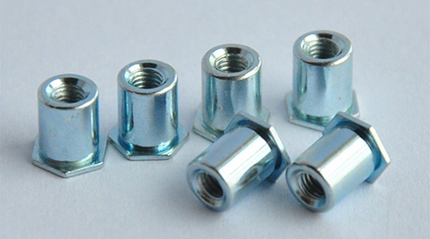The principle of Self Clinching Studs is to press the embossing teeth into the preset holes of the sheet metal. Generally, the diameter of the square preset holes is slightly smaller than the embossing teeth of the clinching studs, and the clinching studs are squeezed by pressure. Inserting into the plate will cause plastic deformation around the hole, and the deformation will be squeezed into the guide groove, thereby producing a locking effect. The Pressure Riveting Studs are divided into free-cutting steel Pressure Riveting Studs S type, Pressure Riveting Studs CLS type, stainless steel pressure riveting studs SP type and copper and aluminum pressure riveting studs CLA type. environment of use. Sizes are usually from M2 to M12. There is no unified national standard for pressure riveting studs, which are often used in chassis cabinets and sheet metal industries.

Introduction of anti-loosening methods for pressure riveting studs:
(1) Collision prevention
1. The spring gasket is anti-loose
The material of the spring washer is spring steel. After installation, the washer is flattened, and its rebound force can maintain the compression force and friction force between the threads, and then realize the anti-loosening and anti-loosening of the top nut, and use the nut to top effect to make the bolt type It is subjected to additional pulling force and additional friction force. Because one more nut is used, and the work is not very reliable, it has been used less and less at present.
2.Self locking nuts
One end of the nut is made into a non-circular closing or a radial closing after slit. When the nut is tightened, the closing expands, and the elastic force of the closing is used to compress the screwed threads. This anti-loosening structure is simple and reliable. The anti-loosening function can be disassembled and assembled without dropping.
3. Elastic ring self clinching nuts anti-loosening
Fiber or nylon is embedded in the screw thread to increase the friction force. The elastic ring also plays a role in preventing liquid leakage.
(2) Mechanical anti-loosening
①Slot nut and cotter pin anti-loosening
After the slotted nut is tightened, use a cotter pin to pass through the small hole at the end of the bolt and the groove of the nut, or use a general nut to tighten and drill the pin hole.
②Round nut and stop washer
Insert the inner tongue of the washer into the groove of the bolt (shaft), and then fold one of the outer tongues of the washer into a groove of the nut after tightening the nut.
③Stop washer
After the nut is tightened, bend the single-ear or double-ear stop washer to the side of the nut and the connected part respectively to achieve anti-loosening. If the two bolts need to be locked in double lock, a double stop washer can be used piece.
④Series steel wire anti-loosening
Use low-carbon steel wires to penetrate the holes in the head of each screw, and connect the screws in series to make them brake each other. This structure needs to pay attention to the direction in which the wires penetrate.
Previous: About Cold Heading Self Clinching Studs
Next: